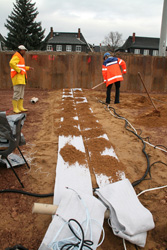Sensing impending disaster
Textile reinforcement is becoming increasingly common. It is used to protect buildings against earthquakes, land and other structures against heavy rainfall, and roads against all sorts of loads and natural disasters. A European consortium made important improvements to geotextiles with EU funding of the ‘Polyfunctional technical textiles against natural hazards’ (Polytect) project. Building on recent advances in materials research, the Polytect team created truly multifunctional textiles. Scientists developed novel sensors, data processing techniques and adhesives. Polytect fabrics incorporated the technology to provide information related to stresses, deformations, water levels and environmental chemical contamination. The geotextiles also enabled structural health monitoring (SHM) to detect structural defects and facilitate timely action. Product functionality and performance were evaluated with a series of field tests both on masonry and geotechnical sites. Commercialisation of Polytect technology will make it possible for civil engineers to conduct preventive maintenance when a potential threat is detected rather than simply hoping that structures will withstand natural disasters. Although reinforcing textiles have been around for a while, they have entered a whole new phase with help from the Polytect project consortium.







